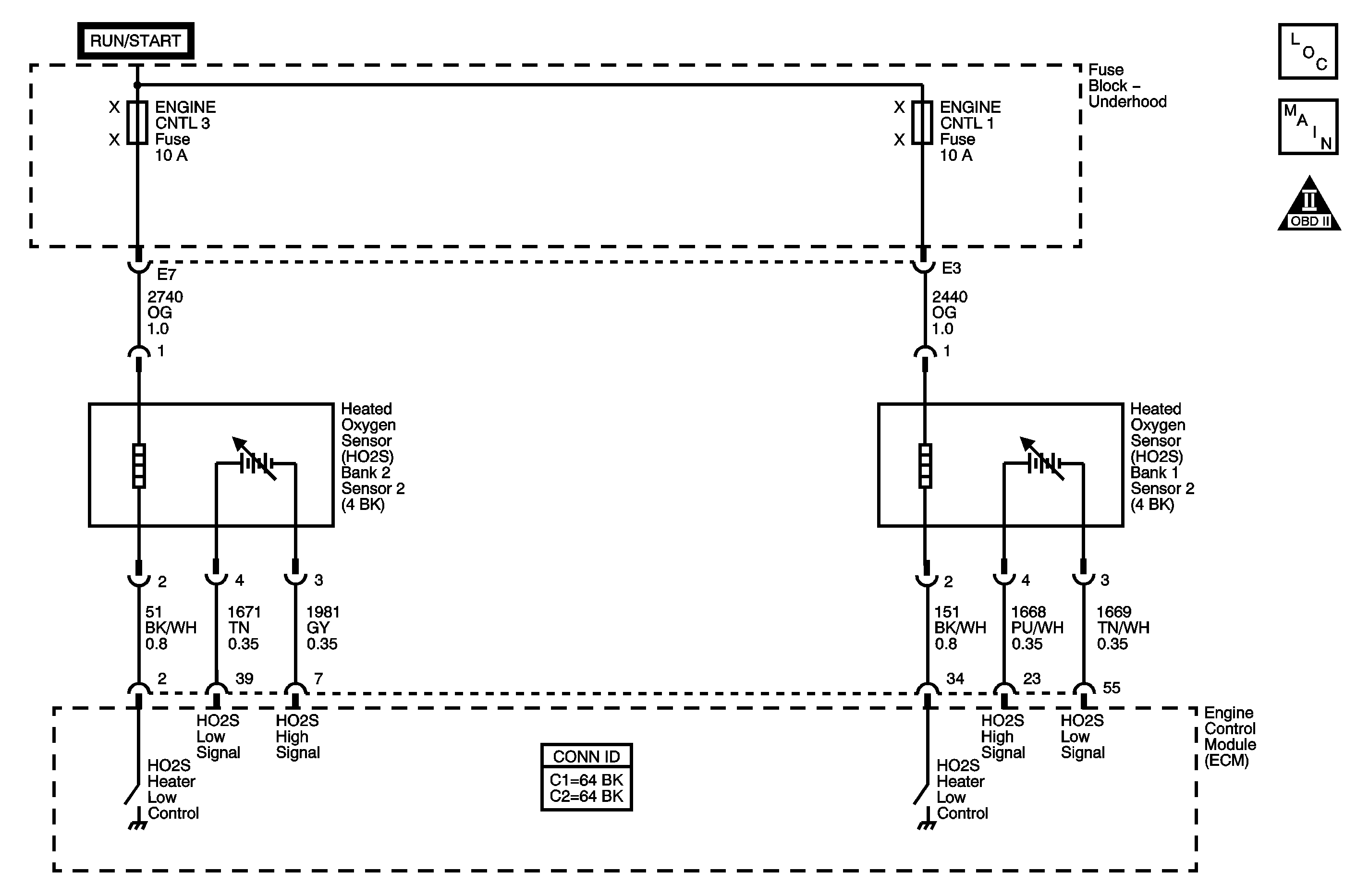
Circuit Description
The heated oxygen sensor (HO2S) produces a voltage that varies between 100-900 mV under normal operating conditions. The engine control module (ECM) produces a bias voltage on the HO2S signal circuit of 420-480 mV. The reference ground for the sensor is provided through the ECM. The ECM monitors the signal voltage to determine if the exhaust is lean or rich. The oxygen sensor voltage is high when the exhaust is rich, and low when the exhaust is lean. The ECM constantly monitors the HO2S signal during the Closed Loop operation. If the ECM detects an HO2S voltage that stays below a specified value, DTC P0136 will set for bank 1 sensor 2, or DTC P0156 will set for bank 2 sensor 2.
Conditions for Running the DTC
| • | DTCs P0442, P0443, P0446, P0449, P0451, P0452, P0453, P0455, P0458, P0459, 0496, P0498, P0499 are not set. |
| • | The engine is running. |
| • | The Battery Voltage parameter is more than 11 volts. |
| • | The Loop Status Bank 1 Sensor 2 or Loop Status Bank 2 Sensor 2 parameter is Closed. |
| • | The Fuel Level parameter is more than 10 percent. |
| • | The calculated catalytic converter temperature is less than 940°C (1724°F). |
Conditions for Setting the DTC
The ECM detects that the HO2S parameter is less than 40 mV for longer than 80 seconds.
Action Taken When the DTC Sets
| • | The control module illuminates the malfunction indicator lamp (MIL) on the second consecutive ignition cycle that the diagnostic runs and fails. |
| • | The control module records the operating conditions at the time the diagnostic fails. The first time the diagnostic fails, the control module stores this information in the Failure Records. If the diagnostic reports a failure on the second consecutive ignition cycle, the control module records the operating conditions at the time of the failure. The control module writes the operating conditions to the Freeze Frame and updates the Failure Records. |
Conditions for Clearing the MIL/DTC
| • | The control module turns OFF the malfunction indicator lamp (MIL) after 3 consecutive ignition cycles that the diagnostic runs and does not fail. |
| • | A current DTC, Last Test Failed, clears when the diagnostic runs and passes. |
| • | A history DTC clears after 40 consecutive warm-up cycles, if no failures are reported by this or any other emission related diagnostic. |
| • | Clear the MIL and the DTC with a scan tool. |
Step | Action | Values | Yes | No | ||||||||||||
|---|---|---|---|---|---|---|---|---|---|---|---|---|---|---|---|---|
Schematic Reference: Engine Controls Schematics Connector End View Reference: Engine Controls Connector End Views | ||||||||||||||||
1 | Did you perform the Diagnostic System Check-Engine Controls? | -- | Go to Step 2 | |||||||||||||
2 |
Does the scan tool indicate that the HO2S voltage is less than the specified value? | 40 mV | Go to Step 4 | Go to Step 3 | ||||||||||||
3 |
Did the DTC fail this ignition? | -- | Go to Step 4 | Go to Intermittent Conditions | ||||||||||||
4 |
Is the voltage within the specified range? | 425-525 mV | Go to Step 6 | Go to Step 5 | ||||||||||||
5 | Test the HO2S high signal circuit for a short to ground or a short to the low signal circuit. Refer to Circuit Testing and Wiring Repairs in Wiring Systems. Did you find and correct the condition? | -- | Go to Step 11 | Go to Step 8 | ||||||||||||
6 | The HO2S may be detecting a lean exhaust condition. Inspect for one of the following conditions:
Repair any of the above or similar engine conditions as necessary. Did you find and correct the condition? | -- | Go to Step 11 | Go to Step 7 | ||||||||||||
7 | Inspect for poor connections at the harness connector of the HO2S sensor. Refer to Testing for Intermittent Conditions and Poor Connections and Connector Repairs in Wiring Systems. Did you find and correct the condition? | -- | Go to Step 11 | Go to Step 9 | ||||||||||||
8 | Inspect for shorted terminals and poor connections at the harness connector of the ECM. Refer to Testing for Intermittent Conditions and Poor Connections and Connector Repairs in Wiring Systems. Did you find and correct the condition? | -- | Go to Step 11 | Go to Step 10 | ||||||||||||
9 | Replace the affected HO2S. Refer to Heated Oxygen Sensor Replacement - Bank 1 Sensor 2 or Heated Oxygen Sensor Replacement - Bank 2 Sensor 2 . Did you complete the replacement? | -- | Go to Step 11 | -- | ||||||||||||
10 | Replace the ECM. Refer to Engine Control Module Replacement . Did you complete the replacement? | -- | Go to Step 11 | -- | ||||||||||||
11 |
Did the DTC fail this ignition? | -- | Go to Step 2 | Go to Step 12 | ||||||||||||
12 | Observe the Capture Info with a scan tool. Are there any DTCs that have not been diagnosed? | -- | System OK | |||||||||||||
